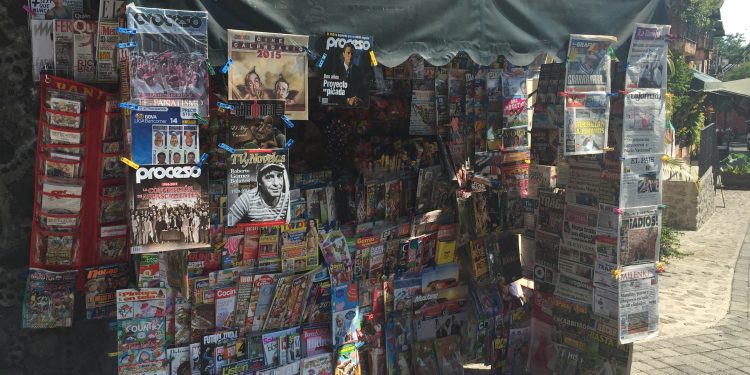For a country where people read notoriously few books, and not too many newspapers, Mexico has a reasonably large number of newsstands and vendors – on just about every street corner, in fact.
The larger stands sell more than just newspapers. They usually stock a variety of magazines, and also sell “special” collections of DVDs, books, and other items (fountain pens, toys, models), which come in weekly deliveries.
Then there are the slightly more mobile street vendors, who wend their way in and out of the cars stopped at traffic lights, alongside the sellers of bottled water, chewing gum, loose cigarettes, etc.
The newspaper vendors rely to a certain extent on the sensational nature of the top story, and the tabloid editions are happy to oblige with murders, scandals or busty models on the front and back pages.
These sellers have developed a skill for allowing potential buyers time to see the headline, but not to read the smaller print above or below that clarifies what the story is really about. Just as you peer more closely at the paper, it will be turned away, flipped, or covered up with the classified ads section or some other unreadable thing. If you want to know, you have to pay.
This is fair game. After all, once you’ve bought an edition or two, you’ll discover that there’s usually not that much behind the headline, so keeping you from reading more is actually a business proposition.
Clearly there are enough people that read newspapers to keep this hive of activity going. One thing that might limit newspaper readership is the cost. With wages what they are, for many people the price of a daily newspaper – 10 pesos for a serious paper – can be prohibitive.
The obvious answer would seem to be the free paper, but for some reason this hasn’t worked. Some time ago, a free eight-page paper was handed out at Metro stations every morning, and people would actually line up to get one.
The metro paper, or El M, not to be confused with Metro, the tabloid published by the Reforma group – soon went out of production. Here’s a clue as to what may have happened to it. The edition was produced by El Universal, which also sells its own cheap tabloid edition – El Gráfico – so the giving away of free papers was doing no favors to the voceadores, as the newspaper sellers are known. Not long before El M’s disappearance, certain voceadores were selling El Gráfico and giving the metro paper free to those who forked out the three pesos for the paid paper.
Mexico in your inbox
Our free newsletter about Mexico brings you a monthly round-up of recently published stories and opportunities, as well as gems from our archives.

